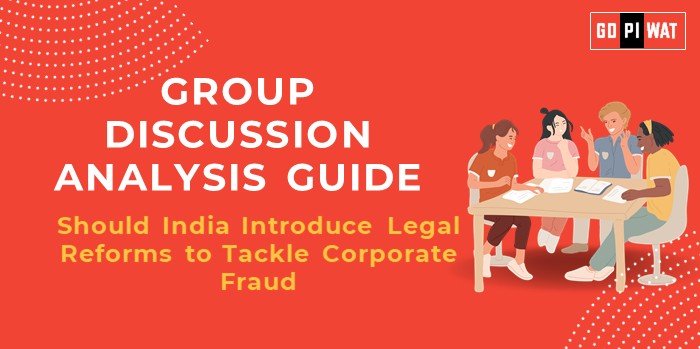📋 Group Discussion (GD) Analysis Guide: Should India Introduce Legal Reforms to Tackle Corporate Fraud
🌐 Introduction to the Topic
- 💬 Opening Context: Corporate fraud has emerged as a pressing concern, with high-profile cases like Satyam and the recent loan frauds drawing attention to regulatory inadequacies. Strengthening legal frameworks is vital for sustaining investor confidence and economic integrity.
- 📜 Topic Background: Corporate fraud includes deliberate misrepresentation or mismanagement of financial records to deceive stakeholders. While India has legal measures like the Companies Act, 2013, and SEBI regulations, gaps in enforcement and evolving fraud mechanisms necessitate reforms.
📊 Quick Facts and Key Statistics
- 💰 Economic Loss: Corporate fraud in India led to losses exceeding ₹6,000 crore in 2023 (KPMG).
- ⚖️ Legal Backlog: Over 8,000 corporate fraud cases remain unresolved in Indian courts (Law Ministry, 2024).
- 🌍 Global Comparison: The U.S. SEC resolved 70% of corporate fraud cases in under two years (2023).
- 📉 Stakeholder Trust: 65% of investors cite fraud risk as a deterrent to investing in Indian companies (FICCI, 2024).
🔍 Stakeholders and Their Roles
- 🏛️ Government: Formulates and enforces laws, ensures transparency.
- 🏢 Corporates: Compliance with laws, promoting ethical practices.
- 👥 Investors: Advocates for accountability and governance reforms.
- ⚖️ Judiciary: Expedites fraud-related cases, ensures fair trials.
- 📊 Regulators (SEBI, RBI): Monitors corporate activities, imposes penalties for violations.
🏆 Achievements and Challenges
Achievements:
- 📜 Introduction of SFIO: The Serious Fraud Investigation Office investigates complex corporate fraud cases.
- ⚖️ Implementation of IBC: The Insolvency and Bankruptcy Code streamlines debt resolution processes.
- 💻 Digitalization: Digital corporate records enhance transparency and reduce manipulation risks.
Challenges:
- 🛡️ Lack of Whistleblower Protection: Insufficient safeguards deter reporting of fraudulent activities.
- ⏳ Judicial Delays: Cases span decades, undermining justice delivery.
- 💸 Weak Penalty Structures: Penalties are often insufficient to deter large-scale fraud.
🎯 Structured Arguments for Discussion
- ✅ Supporting Stance: “Introducing stricter laws will ensure corporate accountability and boost investor trust.”
- ⚖️ Opposing Stance: “India already has sufficient laws; the issue lies in enforcement and judicial delays.”
- 🤝 Balanced Perspective: “While reforms are crucial, equally important are mechanisms for enforcement and speedy resolution.”
🗣️ Effective Discussion Approaches
- 📜 Opening Approaches:
- “India loses over ₹6,000 crore annually due to corporate fraud—prompt reforms are critical.”
- “The Satyam scandal exemplifies how governance lapses can devastate stakeholders.”
- 🔄 Counter-Argument Handling:
- “While laws exist, the lack of whistleblower protection undermines their efficacy.”
- “Judicial delays weaken enforcement, highlighting the need for fast-track courts.”
🔍 Strategic Analysis of Strengths and Weaknesses
- 💪 Strengths: Strong regulatory bodies (e.g., SEBI), availability of laws like IBC.
- 🔧 Weaknesses: Judicial delays, limited digital forensic capabilities.
- 🌟 Opportunities: Leveraging AI for fraud detection, international collaborations for governance standards.
- ⚠️ Threats: Sophisticated fraud techniques, cross-border financial crimes.
💼 Connecting with B-School Applications
Real-World Applications: Projects on legal frameworks’ role in risk management, integrating AI in fraud detection.
Sample Interview Questions:
- 💡 “What role can technology play in mitigating corporate fraud?”
- 💡 “Analyze India’s corporate governance mechanisms compared to global standards.”
Insights for B-School Students:
- Explore careers in forensic accounting and compliance.
- Develop projects around regulatory challenges and reforms.


